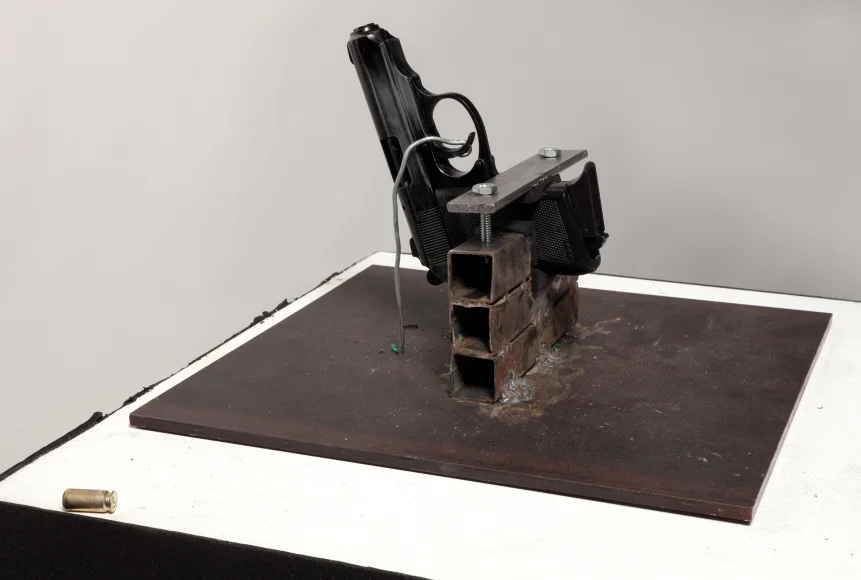Take a Bullet for the City
While Luke Dubois has pioneered the technical aspects of the generative audio/visual realm, he distinguishes himself artistically with the poignant political or social commentaries he makes. One such piece was commissioned for a group exhibition in New Orleans titled, Guns in the Hands of Artists. The show exhibited work from over thirty different artists who used decommissioned handguns and rifles taken from the streets of New Orleans by the New Orleans Police Department’s gun buyback program. Dubois’ contribution,Take a Bullet for the City, was an installation which incorporated elements of sound, sculpture, and data visualization. The installation consists of a Walther PPk 9mm hand gun, a steel plate, an engineered mechanism to operate the trigger of the gun, and a minicomputer to pull data from New Orleans Police Department. Over the course of the month the piece was installed, the gun would fire a blank on approximately a week delay every time the NOPD received a report of a firearm discharge.
“a Walther PPK fires on a schedule based on the shootings reported by the public to the NOPD a week and twelve hours ago in time, commemorating, a week later, violence that is so common as to be quickly forgotten as individual occurrences. A visitor to the gallery at 10am on Sunday is hearing the shootings of 10pm the Saturday before. These time-shifted events are intended to alarm, marking time by sudden bursts of violent noise followed by the ever-rising tide of spent cartridges at the sculpture’s base.” (Luke Dubois)
The spent cartridges act as a visualization of the reported shootings and the jarring blast of the gun is meant to alarm the exhibition visitors.
Filling a silent gallery with such violent noise is important to the effectiveness of the piece conceptually. The nature of the piece forces its critics to come into contact with its concepts regardless of their physical position within the gallery.
“The noise and flash of the gun provides an alarm that is itself meant to alarm; the vitrine resembles a wishing well, only it represents wishes taken away, not granted. This piece is hard data in both senses of the word: it is based on facts; facts that are, by their very nature, intended to hurt us.” (Luke Dubois)
The idea stems from the middle ages when townspeople relied on a “town crier” to act as the village siren. In this instance, the gun becomes the “town crier” and the shot a cry for the end to gun violence. The symbolic vitrine is a silent reflection on the ongoing issue. When paired together, Dubois creates a powerful installation that tackles a real life issue head on. The use of real data provided by the NOPD firmly roots this piece in the realities of the current situation. The double entendre in ‘hard data’ speaks to the sophisticated conceptual grounds on which Dubois creates this work. He is not only thinking about the data visually and sonically but on a deeper conceptual level as the data relates to real life political issues. Thus he concludes his artist statement with the declaration of this piece as “the new town crier, but in reverse; all will be well only when this gun finally falls silent.” Dubois does not only want to shock the gallery visitors with the sound of a gun shot, he hopes to mobilize the public towards bringing an end to the violence.
The emotional power of data visualization can be seen in other works exhibited at the same show such as Generic Art Solution’s One Hot Month. The tiled mosaic of twenty-seven portraits is a collection of silkscreen on photogram. Each portrait was taken from the obituaries section of the newspaper in August 2002 listed under “death by gunshot.” The piece reminds us of the deadly nature of guns and the regrettable circumstances under which these fatal accidents take place. By choosing August, the artists highlight how a simple grievance can be blown out of proportion in the sweltering New Orleans summer heat. While this may be considered a much different approach to data visualization, this piece, like DuBois’, is effective at evoking an emotional response from the audience. The portraits on the wall force the viewer to engage with with shear number of death— almost one a day— in the same way Dubois’ work forces one to engage with high volume of gun shots.
Dubois’ political work is not limited to his piece on gun violence. Another area his work deals with politically is in the realm of political rhetoric. In one such instance, he blends the acceptance speeches given by President Barak Obama and Governor Mitt Romney at their respective party conventions in 2012. Using a computer algorithm, Dubois subjects their speeches to a never-ending editing process that attempts to synchronize the speeches wherever possible. The two speeches contained around 1500 unique words with 85% of those words overlapping. The result is a juxtaposition that exemplifies little in the way of difference between the two candidates. While the artistic output of this piece differs greatly from his installation work, the political overtones again give his work a poignant conceptual framework.
Links -
http://lukedubois.com/
http://cantaloupemusic.com/artists/r-luke-dubois
http://www.jonathanferraragallery.com/exhibitions/guns-in-the-hands-of-artists/selected-works?view=slider#36
http://www.vice.com/read/placing-guns-in-the-hands-of-artists
http://www.nytimes.com/2014/01/12/arts/design/r-luke-dubois-mines-data-to-reveal-art.html?_r=0







